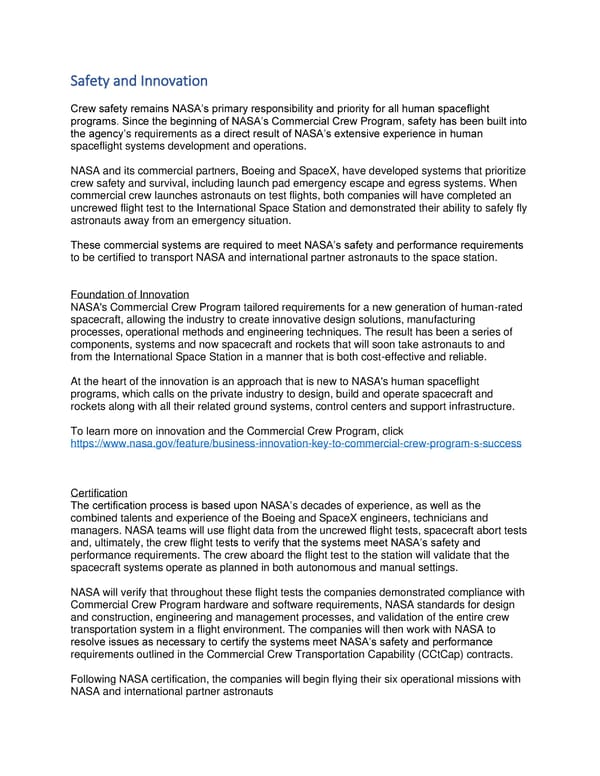Safety and Innovation Crew safety remains NASA’s primary responsibility and priority for all human spaceflight programs. Since the beginning of NASA’s Commercial Crew Program, safety has been built into the agency’s requirements as a direct result of NASA’s extensive experience in human spaceflight systems development and operations. NASA and its commercial partners, Boeing and SpaceX, have developed systems that prioritize crew safety and survival, including launch pad emergency escape and egress systems. When commercial crew launches astronauts on test flights, both companies will have completed an uncrewed flight test to the International Space Station and demonstrated their ability to safely fly astronauts away from an emergency situation. These commercial systems are required to meet NASA’s safety and performance requirements to be certified to transport NASA and international partner astronauts to the space station. Foundation of Innovation NASA's Commercial Crew Program tailored requirements for a new generation of human-rated spacecraft, allowing the industry to create innovative design solutions, manufacturing processes, operational methods and engineering techniques. The result has been a series of components, systems and now spacecraft and rockets that will soon take astronauts to and from the International Space Station in a manner that is both cost-effective and reliable. At the heart of the innovation is an approach that is new to NASA's human spaceflight programs, which calls on the private industry to design, build and operate spacecraft and rockets along with all their related ground systems, control centers and support infrastructure. To learn more on innovation and the Commercial Crew Program, click https://www.nasa.gov/feature/business-innovation-key-to-commercial-crew-program-s-success Certification The certification process is based upon NASA’s decades of experience, as well as the combined talents and experience of the Boeing and SpaceX engineers, technicians and managers. NASA teams will use flight data from the uncrewed flight tests, spacecraft abort tests and, ultimately, the crew flight tests to verify that the systems meet NASA’s safety and performance requirements. The crew aboard the flight test to the station will validate that the spacecraft systems operate as planned in both autonomous and manual settings. NASA will verify that throughout these flight tests the companies demonstrated compliance with Commercial Crew Program hardware and software requirements, NASA standards for design and construction, engineering and management processes, and validation of the entire crew transportation system in a flight environment. The companies will then work with NASA to resolve issues as necessary to certify the systems meet NASA’s safety and performance requirements outlined in the Commercial Crew Transportation Capability (CCtCap) contracts. Following NASA certification, the companies will begin flying their six operational missions with NASA and international partner astronauts
 NASA, SpaceX & Boeing | Commercial Crew Program Page 30 Page 32
NASA, SpaceX & Boeing | Commercial Crew Program Page 30 Page 32